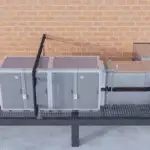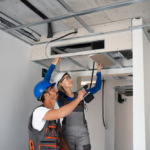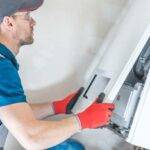As the temperatures drop, a reliable heating system becomes essential for a comfortable living space. At High Comfort, we understand the importance of a well-functioning heating system and the steps involved in its installation.
You’re taking the first step towards a warmer home by understanding the HVAC installation process. Our approach is designed to be straightforward. This ensures you feel informed and comfortable throughout the heating installation steps.
From initial consultation to final testing, our team guides you through every stage. We make sure your new heating system is installed correctly and functions efficiently.
Key Takeaways
- A successful heating installation starts with a thorough initial consultation.
- Our team ensures a smooth installation process, keeping you informed every step of the way.
- Final testing guarantees your new heating system functions efficiently and effectively.
- Understanding the HVAC installation process helps you prepare for a cozy home.
- Our straightforward approach makes the heating installation steps clear and manageable.
Understanding Your Heating Installation Options
Choosing a heating system is more than picking a type. It’s about finding one that fits your lifestyle and preferences. Knowing your options is key to making a smart choice.
Types of Heating Systems Available
There are many heating systems to choose from, each with its own benefits. Here are some of the most common:
- Forced Air Systems: Quick to install and effective, these systems use ducts to distribute warm air throughout your home.
- Radiant Heating Options: Providing consistent warmth, radiant heating systems are installed under the floor or behind walls.
- Heat Pumps and Hybrid Systems: Energy-efficient and versatile, heat pumps can provide both heating and cooling, while hybrid systems combine different heating sources for optimal efficiency.
Forced Air Systems
Forced air systems are a favorite for their fast installation and effectiveness. They heat air and send it through ducts to your home’s different areas.
Radiant Heating Options
Radiant heating warms your space by installing heating elements under the floor or behind walls. It ensures a steady and cozy temperature in your home.
Heat Pumps and Hybrid Systems
Heat pumps are energy-efficient because they transfer heat instead of making it. Hybrid systems go further by mixing different heating sources to save energy and cut costs.
Professional vs. DIY Installation Considerations
Deciding between a professional or DIY installation is important. DIY might save money, but professional installation ensures the job is done right and safely. It follows local building codes and rules.
Timing Your Installation for Minimal Disruption
Timing is everything when scheduling your heating installation. Install during the off-season to avoid disrupting your daily life. This way, you’ll be all set for the cold weather.
Pre-Installation Planning and Preparation
Good planning is key to a smooth heating installation. You need to think about a few things to make the process easy and quick.
Home Assessment and Heat Load Calculation
First, you need to assess your home. This helps figure out the right heating system size and type. A pro will look at your home’s size, insulation, windows, and climate. They make sure your new system will heat your home well.
Budgeting and Financing Your Heating Installation
Knowing your budget is important. The cost changes based on the system and how hard it is to install. Knowing average costs helps you choose wisely.
Average Costs by System Type
| System Type | Average Cost |
| Gas Furnace | $1,000 – $3,000 |
| Heat Pump | $1,500 – $4,000 |
| Electric Furnace | $800 – $2,000 |
Available Rebates and Incentives
There are rebates and incentives for energy-efficient systems. These can lower the cost of your new heating. Some programs give rebates for systems that save energy.
- Utility company rebates
- Government incentives
- Manufacturer discounts
Obtaining Necessary Permits and Approvals
Get the right permits before starting. Your contractor should take care of this. They make sure everything is done right and follows local rules.
Preparing Your Space for Installation Day
Get your home ready for the install team. Clear the area, protect your floors and furniture, and make sure the team can get to the work area easily.
Being ready and knowing what to do before installation makes the process smoother. This way, your heating installation will go well.
What is the Process for Heating Installation? A Step-by-Step Guide
The heating installation process is detailed, but a step-by-step guide makes it easier. Knowing the stages helps you prepare for your new heating system.
Initial Consultation and System Selection
Your journey starts with an initial consultation. Here, you talk about your heating needs with a pro. They consider your home’s size, insulation, and ductwork to suggest the best system.
A leading HVAC expert says, “A good initial consultation is key. It ensures the chosen system fits your needs and works well.” The right system boosts your energy efficiency and comfort.
Removal of Existing Heating System (If Applicable)
If you’re getting a new system, removing the old one comes next. This step is done carefully to avoid damage or hazards. Experts will safely disconnect and remove the old system, disposing of it correctly.
Installation of the New Heating Unit
Installing the new unit is a major step. It includes several important tasks:
Positioning and Securing the Unit
The new unit must be placed correctly for best performance and safety. It’s secured and checked to be level.
Connecting Ductwork and Venting
Connecting ductwork and venting is key for your system’s efficiency. This step needs precision to prevent leaks or inefficiencies.
Electrical and Fuel Line Connections
Making electrical and fuel line connections is a precise task. It requires expertise and must meet safety standards.
“A well-installed heating system is about more than comfort,” says a top HVAC expert. “It’s also about safety and efficiency.” Ensuring connections are secure is critical.
Common Installation Challenges and Solutions
Even with planning, installation can face challenges. Issues like ductwork problems or electrical connection complexities can arise. Experienced installers know how to solve these problems.
- Checking ductwork for damage or leaks
- Ensuring electrical connections are safe
- Fixing fuel line connection issues
Safety Considerations During Installation
Safety is top priority during installation. Professionals follow strict safety rules to protect you and your home. They wear protective gear, ensure ventilation, and follow safety codes.
Understanding the heating installation process shows the complexity and care needed. With the right professionals, you’ll have a warm and cozy home.
Testing, Commissioning, and Quality Assurance
After installing your new heating system, it’s time for thorough testing and commissioning. This step is key to making sure your system works right. It also ensures it’s safe and efficient.
Initial System Testing Procedures
The first tests check if your heating system is working well. They look for leaks and make sure all parts work together. These tests help find problems early, so they can be fixed quickly.
Thermostat Installation and Programming
The thermostat controls your home’s temperature. It’s important to install and program it right. A good thermostat can save energy and make your home more comfortable. Your installer will make sure it’s set up just for you.
Final Inspections and Safety Checks
Before you start using your system, it gets a final check. This makes sure it’s safe and working right. They look for wear and make sure safety features are on.
A leading HVAC expert says, “Safety is the most important thing in heating system installation. A good safety check can prevent accidents and keep everyone safe.”
“A well-installed heating system is not just about comfort; it’s also about safety and efficiency.”
– HVAC Expert
Homeowner Orientation and System Operation Training
The last step is teaching you how to use your new system. You’ll learn how to adjust settings and solve simple problems. This training helps you use your system well and avoid issues.
Here’s a quick summary of the important steps in testing, commissioning, and quality assurance:
| Procedure | Description | Importance |
| Initial System Testing | Validates system performance, checks for leaks | High |
| Thermostat Installation and Programming | Ensures efficient temperature control | High |
| Final Inspections and Safety Checks | Verifies safe operation, checks for hazards | Critical |
| Homeowner Orientation and Training | Educates homeowner on system use and troubleshooting | Essential |
Conclusion: Ensuring Long-Term Comfort and Efficiency
Now that you’ve finished installing your heating system, it’s time to enjoy the warmth. At High Comfort, we aim to make your experience with your new system exceptional. To keep your home comfortable and efficient, regular maintenance is key.
This includes changing filters and getting annual professional checks. These steps are vital for your heating system’s long life and performance. Following a professional guide and sticking to the recommended steps will keep your system running smoothly. This ensures your home stays cozy for years.
Knowing the heating installation process and keeping up with maintenance will let you enjoy your system for a long time. At High Comfort, we’re dedicated to providing quality and satisfaction. We’re here for you, from installation to ongoing support.
FAQ
What is the typical process for heating installation?
The heating installation process starts with a consultation. Then, you choose a system. Next, the old system is removed, if there is one.After that, the new unit is installed. The final steps include testing and making sure everything works right.
How long does a heating installation take?
The time it takes to install a heating system varies. It depends on the job’s complexity, the system type, and your home’s size. Simple jobs might take a few hours, while bigger ones could take a whole day.
What are the different types of heating systems available?
There are many heating systems out there. You can choose from forced air, radiant heating, or heat pumps. Each has its own benefits and fits different needs.
Can I install a heating system myself, or do I need a professional?
DIY installation might save money, but it’s safer and more reliable to hire a pro. Professionals ensure the job is done right, which is important for complex systems.
How do I prepare my home for heating installation?
To get ready for heating installation, clear the area where the system will go. Make sure you have access to electrical and fuel lines. Also, cover your floors and furniture to avoid dust and debris.
What are the average costs associated with heating installation?
Heating installation costs vary a lot. They depend on the system, how complex the job is, and your home’s size. Knowing the average costs and looking for rebates can help you decide.
Are there any rebates or incentives available for heating installation?
Yes, there are rebates and incentives for heating installation. These include government programs and offers from utility companies. They can help lower the cost of your new system.
How do I maintain my new heating system?
To keep your heating system in good shape, change the filters regularly. Also, have a pro inspect it every year. Follow the manufacturer’s maintenance and troubleshooting tips.
What is involved in the testing and commissioning of a new heating system?
Testing and commissioning start with initial system checks. Then, the thermostat is installed and set up. After that, there are final inspections and safety checks to make sure everything works right and safely.




